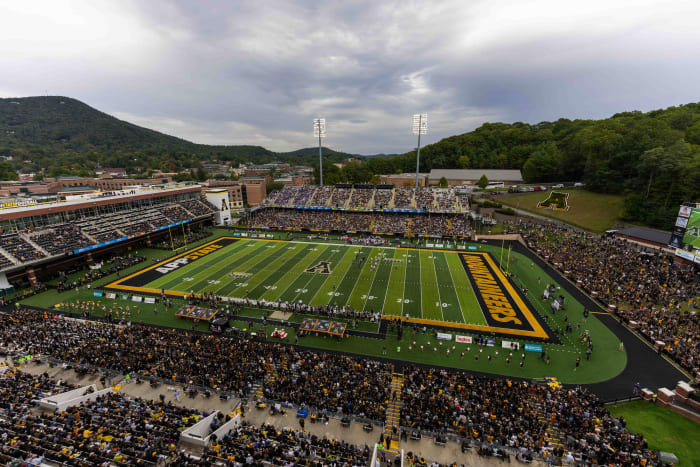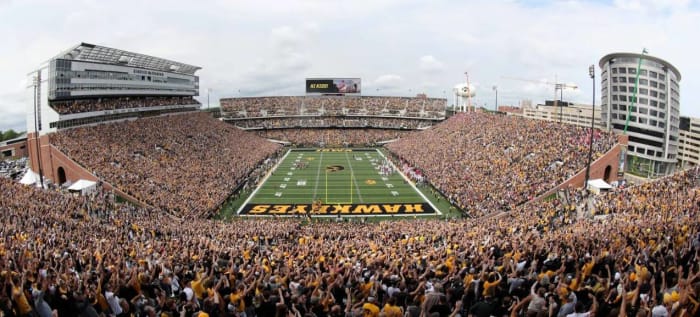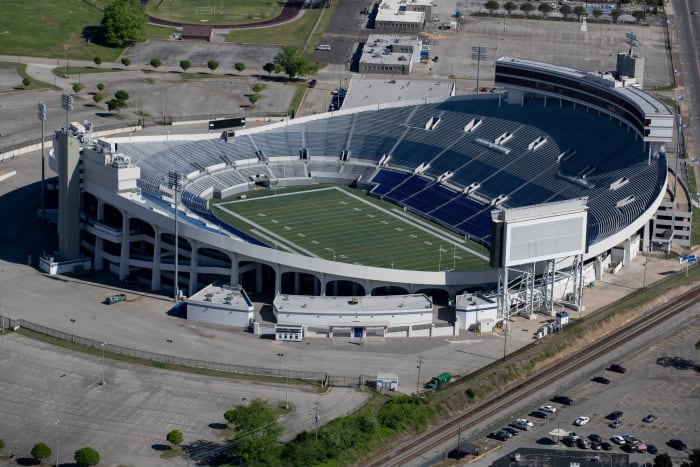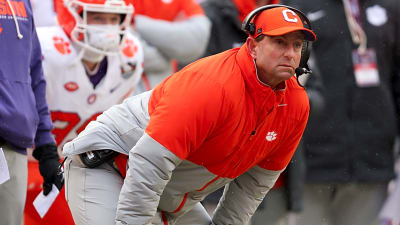There are iconic, uniquely legendary college football venues throughout the country, and then there are stadiums that deserve more credit. Here's our list of the latter, listed alphabetically.
1 of 20
Kidd Brewer Stadium (Appalachian State)
David Yeazell/USA TODAY Sports
Also known as "The Rock." Situated a little more than 3,300 feet above sea level, amid the Blue Ridge Mountains, in Boone, N.C. Kidd Brewer opened in 1962, when it was known as Conrad Stadium, and has provided a strong home-field advantage for the Mountaineers at the FCS and FBS levels. Sure, the stadium is known to outsiders for its scenic beauty; however, when packed (record 40,168 set in 2022, matched in 2023), it can be quite the burden for opposing teams. App State owned a 30-game home winning streak from November 2002 to October 2007.
2 of 20
Michie Stadium (Army)
Army West Point Athletics
One gets a pleasant view of the Hudson River if seated high enough in the west stands. There aren't many more scenic venues in all of sports than the home field of the Cadets in West Point, N.Y. Michie, named after cadet Dennis Michie, who played a major role in starting the Army football program and was the team's first coach, celebrated its 100th anniversary during the 2023 season. Officially, Michie seats about 38,000, but its most-attended games all topped 41,000. Army has won more than 370 games while residing at Michie.
3 of 20
Jordan-Hare Stadium (Auburn)
Auburn University
We consistently hear about the intimidation factor of LSU's "Death Valley" or the menacing vibration that resonates within the confines of Alabama's Bryant-Denny Stadium. There's "The Grove" at Ole Miss, too. However, often stuck in the shadows of those fine SEC football buildings is this home of the Auburn Tigers. More than 88,000 can pack Jordan-Hare, and it can be intimidating. Not to mention, the game-day atmosphere of tailgating around the stadium and in town is one of the great college football experiences.
4 of 20
LaVell Edwards Stadium (BYU)
Ron Chenoy/USA TODAY Sports
The landscape surrounding the home of the Cougars is quite scenic, and the stadium is named for the legendary and beloved BYU coach. With the Squaw, Y, and Buckley Mountains all in the background, BYU's home field is an open-air wonder that's also rather intimate. The stadium seats more than 63,000, and it always seems the sun is out in glorious form for those day games. Then, there's the history. Jim McMahon, Steve Young, Ty Detmer. Fun fact: A large collection of Jurassic-period fossils was stored under the stadium's stands until 2005.
5 of 20
Folsom Field (Colorado)
Ron Chenoy/USA TODAY Sports
Even before Deion Sanders took over the Buffaloes program, Folsom Field has long been a must-visit college football environment for any college football fan looking for a road trip. Now, the stadium is just a part of the beautiful Boulder campus. In 2024, the stadium turns 100. Though not quite bowl-shaped, the field is highly intimate and can be a pain for opposing teams with a capacity just north of 50,000. The school's athletic offices and "Champions Center," located directly behind the north end zone, and the exposed brick facade are two of the more notable elements of this beautiful facility.
6 of 20
Roos Field (Eastern Washington)
James Snook/USA TODAY Sports
Roos Field is best known for its vibrant red turf (upgraded in 2020) and is home to one of the top programs in FCS. That success has allowed Eastern Washington University to renovate the stadium (which opened in 1967), making it more compact (thus potentially cutting down on the wind that always seems to blow) and intimidating to the opposition. Aka "The Inferno," the Roos is truly a home-field advantage when the Eagles are sporting their all-red uniforms. A still-record crowd of 11,702 saw EWU top rival Montana on Sept. 18, 2010, in the initial game played on the red turf.
7 of 20
Paulson Stadium (Georgia Southern)
Adam Hagy/USA TODAY Sports Status:
A small-school venue with a big-time feel. Paulson Stadium seats about 25,000 (but has surpassed that number) and provides an intimate and potentially raucous college football setting. The addition of a brick facade years back was a nice touch, plus a state-of-the-art elevated video board has allowed Paulson to fit in quite well since the Georgia Southern program moved up to the FBS level in 2014. It also boasts several suites and luxury boxes, but the corner grass seating might be the stadium's best attribute.
8 of 20
Bobby Dodd Stadium (Georgia Tech)
Jason Getz/USA TODAY Sports
In terms of aesthetics, there's not much to write home about Bobby Dodd, which has been around, in its earliest form, since 1905 (making it the oldest current FBS stadium). However, there's something special about the location of the home of the Yellow Jackets. Situated on the east side of Georgia Tech's campus, the stadium is tucked in just west of Interstate 85 and provides brilliant views of the downtown Atlanta skyline. That stadium setting is glorious for night games when the lights of downtown are bright, and the field provides an intimate oasis in a jam-packed southern city. Not to mention, it's a short walk across the expressway to The Varsity drive-in restaurant, which is an institution itself.
9 of 20
Harvard Stadium (Harvard)
Harvard University
The Ivy League's rich institutional history also includes its sports facilities. Harvard Stadium is actually located across the Charles River in Boston and seats roughly 25,000, but it has a coliseum-like vibe, especially when viewing from the outside. Since around 1903, Harvard Stadium has been the oldest permanent concrete structure used for intercollegiate athletics. In addition to hosting the Crimson football team, Harvard Stadium was the site of the United States Olympic men's track and field trials 1912, 1920, 1924,1928, and soccer matches for the 1984 Summer Games.
10 of 20
Kinnick Stadium (Iowa)
University of Iowa
Full disclosure: Kinnick Stadium makes our list due to one of college football's greatest and most recent traditions. Since the University of Iowa Children's Hospital's new facility opened next door to the stadium in 2017, those in attendance and on the field wave to patients and families looking on at the end of the first quarter. Known as The Hawkeye Wave, it's a remarkably touching gesture that has become a highly anticipated moment like no other tradition in the stadium's history; it opened in 1929, has seen several well-received renovations, and currently seats more than 69,000.
11 of 20
Liberty Bowl (Memphis)
Max Gersh/Memphis Commercial Appeal via Imagn Content Services, LLC/USA TODAY
Yes, this famed Memphis stadium, located on the Mid-South Fairgrounds, would seem outdated. It's a one-tier facility that doesn't have much of a way to install luxury suites that would enhance a venue with a capacity of more than 58,000. However, the home of the Memphis Tigers and historically viable Liberty Bowl postseason contest still has something special to offer in terms of old-school history that still has some value — especially to college football fans who believe said history is still important and worth preserving.
12 of 20
Huntington Bank Stadium (Minnesota)
University of Minnesota
Sure, home games in November can be frosty in the Twin Cities, and snow is always possible. However, at least the current outdoor home of the Golden Gophers (since 2009) is a vast improvement over the sterile confines of the Metrodome. Totally state of the art, complete with near-perfect sightlines, and not to mention that Minnesota fans (more than 50,000 can comfortably fit inside) will get loud enough to cause trouble for the opposition. The view of Minneapolis' downtown skyline also offers another amenity worth the admission price.
13 of 20
Davis Wade Stadium at Scott Field (Mississippi State)
Spruce Derden/USA TODAY Sports
To opposing teams and their fans — should they be up for a road trip — Davis Wade Stadium can be a nightmare, mainly because of those pesky cowbells that the home crowd likes to utilize on just about every occasion for one of the great college football traditions. The stadium first saw service in 1914, thus making it the fourth-oldest college football venue in the sport. More than 61,000 fans (rather small for SEC standards) can pack Davis Wade, and that will happen, especially when it's the Bulldogs' turn to host the annual Egg Bowl versus rival Ole Miss.
14 of 20
Fargodome (North Dakota State)
Brace Hemmelgarn/USA TODAY Sports
Technically, the home of the Bison is not an actual dome. It can probably best be described as an oversized arena that can seat in the neighborhood of 18,000 football fans. With a record nine FCS national championships, NDSU has long been a college football juggernaut at that level, and the Fargodome, which opened for business in 1992, has played a major part in that success. The building can get loud, even if not at full capacity. The Bison's rabid home fans, decked in green and yellow, tend to stand most of the game, and their voices are usually shot when the final whistle blows.
15 of 20
Boone Pickens Stadium (Oklahoma State)
Rob Ferguson/USA TODAY Sports
The school currently known as Oklahoma State has been playing football on this site since 1920, and there remains something special about the home of the Cowboys. Nearly 54,000 can fit inside Boone Pickens Stadium, which may seem quite spacious on television but can be quite compact and intimidating in person. In many ways, the stadium has blossomed into a football fortress. One that has been upgraded to include all the needed modern amenities without losing its overall character and tradition.
16 of 20
Autzen Stadium (Oregon)
Kirby Lee/USA TODAY Sports
There are many notable stadiums and arenas on the West Coast, but Autzen never seems to receive its due credit. Prior to moving into the modern and uniquely designed Autzen Stadium in 1967, the Ducks played at the school's famed Hayward Field (best known as home to Oregon's legendary track and field team). Their current home has a general bowl shape, but the stands are extended upward on each sideline. Situated just off the Willamette River, Autzen Stadium is a true gem for its football purpose and overall beauty.
17 of 20
Ross-Ade Stadum (Purdue)
Purdue University
West Lafayette might not exude the college-town image, but there is something cool about the football home of the Boilermakers. First, the stadium can seat more than 61,000 people, but there is no bad seat in the house. Plus, fans are right on top of the action, as even the highest seats in the stadium can still feel the crunch of the pads as if one were on the sidelines. Not to mention, after exiting out the south end zone, fans walk right into a residence hall quad area that's usually filled with parties or the students' own game of football going on.
Ivan Pierre Aguirre/USA TODAY Sports
Much like the Liberty Bowl, the Sun Bowl certainly has its place in history when it comes to tradition. The stadium was built for the university and, more specifically, to host the Sun Bowl. It opened in 1963, and though the bowl matchups aren't always appealing, the stadium's picturesque location (dug into the foothills) exudes college football tradition. It's still broadcast on CBS, played during the afternoon between Christmas and New Year's Day, and fans get a special treat when it snows on game day. The Sun Bowl seats roughly 50,000 and is truly a special place.
19 of 20
Lane Stadium (Virginia Tech)
Reinhold Matay/USA TODAY Sports
More than 65,000 fans can pack themselves into the home of the Hokies, which feels compact but refreshingly open in certain areas. And man, can this place get going — especially when the home team is about to take the field and Metallica's "Enter Sandman" is blasted to the hilt. That sets off the fan base, nearly all jumping in place. It was an imposing sight, no matter how poorly the Hokies might be performing at the time. Other traditions at this scenic Blacksburg venue include the massive on-field cannon "Skipper" and the popular, family-friendly game-day hangout known as "Hokie Village."
20 of 20
Yale Bowl (Yale)
Yale University
We can't highlight Harvard without including its chief rival, Yale. The Yale Bowl has existed since 1914 and currently seats more than 61,000 — more than its counterpart at Harvard. The name also speaks for itself. The venue is said to have inspired the likes of other famous bowl-shaped stadiums, such as the Rose Bowl and Michigan Stadium. Of course, the game-day traditions, such as the "Bulldogs Walk" and famous tailgating scenes, only add to the legacy of this grand facility.
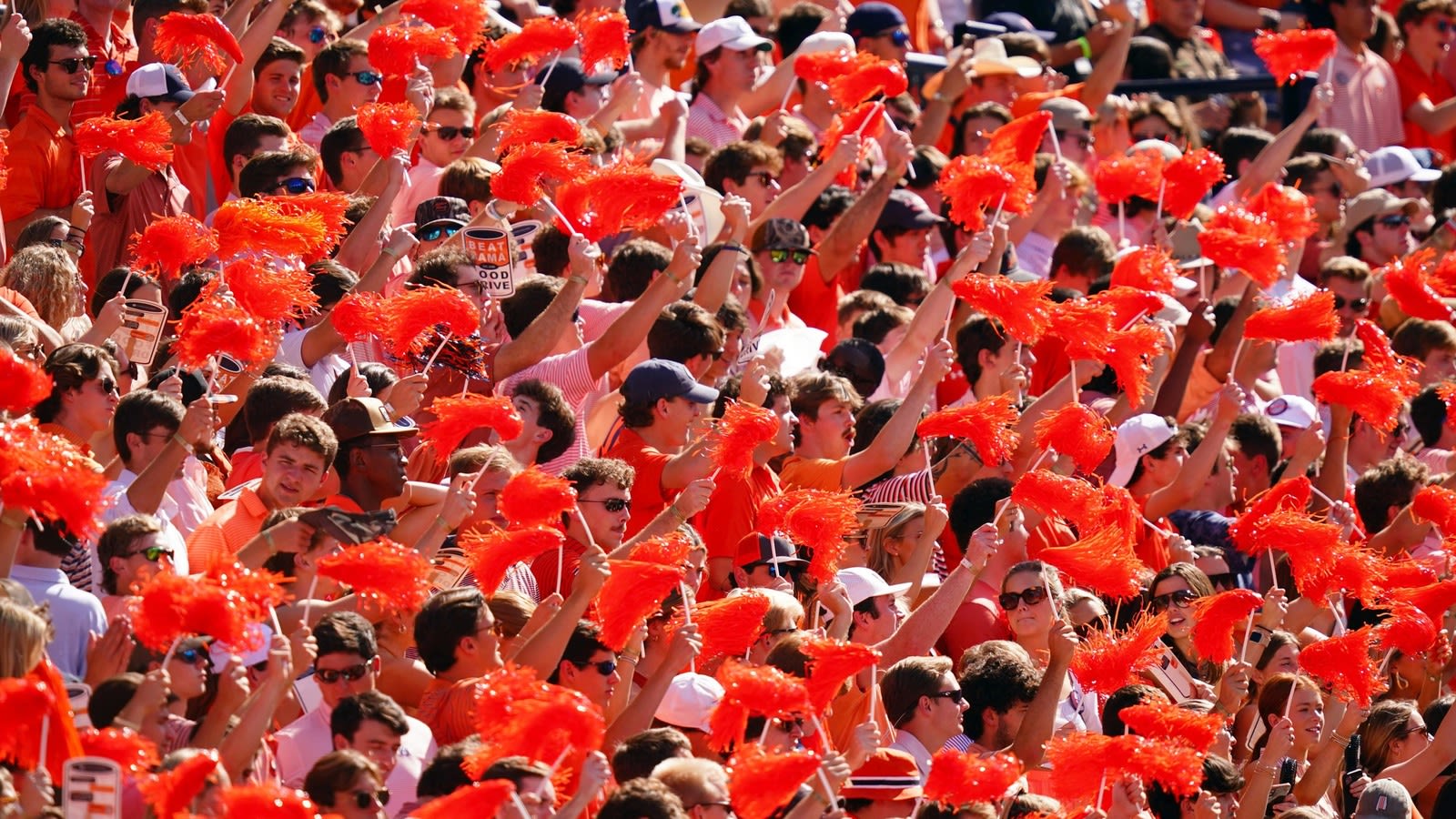
 +
+
